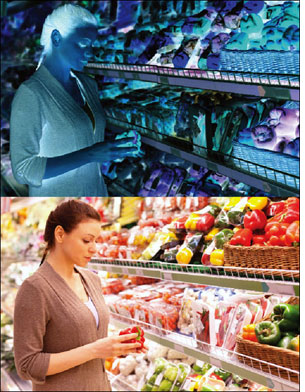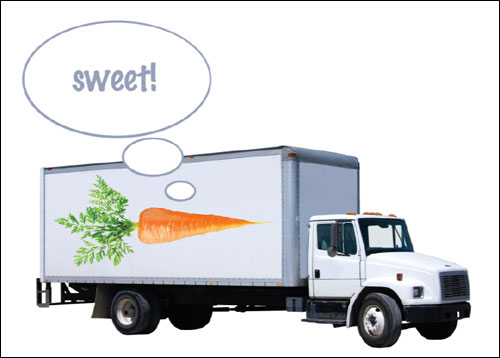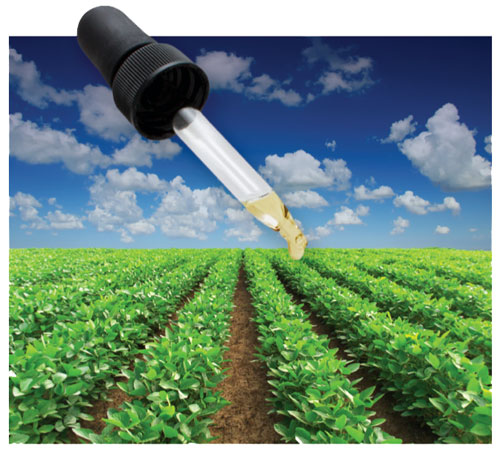Since July 29, people in 12 states have died after eating cantaloupe contaminated with Listeria, and more than 135 people from 28 states have been infected with the bacteria, according to the Centers for Disease Control and Prevention (CDC). It took until Sept. 14 for the U.S. Food and Drug Administration (FDA) to confirm it had traced the multistate outbreak to Jensen Farms, in Colorado. This summer, Europe also experienced a deadly food outbreak, when an unusually lethal strain of E. coli claimed the lives of 50 people in Germany and sickened thousands more in neighboring countries, according to the World Health Organization. German authorities first stated the bacteria had originated in produce grown in Spain, and although that proved to be incorrect, Spanish farmers lost millions of dollars in sales.
Unfortunately, such tragedies are not uncommon. Roughly 48 million Americans get ill from food-borne disease each year, and some 3,000 people die, according to the CDC. In January, President Barack Obama signed the Food Safety Modernization Act (FSMA), which for the first time gives the FDA mandatory recall authority for all food products. The FDA has not yet finalized traceability regulations for implementation and won’t actually prescribe what technology to use. “Right now, people are looking at RFID as a cost-effective way to implement the food trace-back requirements to meet the new mandate,” says Michael McCartney, principal at QLM Consulting.
Indeed, for the past several years, produce suppliers, researchers and technology providers have been piloting RFID projects to track perishable foods from the field to retail, to provide traceability in the event of a recall. After having to recall all its packaged spinach following an E. coli outbreak in 2006 that sickened 200 people, Dole Foods started RFID-tracking vegetables from harvest, through processing and packaging, and on to stores.
More recently, the development of RFID tags equipped with temperature sensors has led some food producers to monitor shipments to keep perishables fresh and safe. Some $35 billion of food is wasted each year, half of it because of temperature mismanagement, according to a study by the University of Florida Food Distribution and Retailing Lab. For each hour a strawberry spends at 70 degrees Fahrenheit, for example, shelf life decreases by a day. Driscoll’s, in the United States, and Bionest, in Spain, are among the early adopters using RFID to monitor strawberry temperatures.
To date, costs, particularly for small farmers, have hampered widespread use of RFID to monitor perishable foods. Now, the need to comply with traceability regulations, coupled with the benefits of temperature tracking, could drive the technology’s adoption. Meanwhile, researchers are exploring ways RFID could help farmers increase crop yields, and some supply-chain partners are identifying RFID applications that can improve efficiencies in their operations.
Global Visibility
The interconnection of monitoring produce for traceability and temperature becomes clearer when you consider the global food supply chain. More than one-third of the fresh produce consumed in the United States comes from outside the country’s borders, says John M. Ryan, owner of consultancy Ryan Systems and former administrator in the Quality Assurance division of the Hawaii State Department of Agriculture, where he led RFID-based produce traceability and cold-chain pilots. Ryan is coordinating an ambitious RFID pilot, getting under way this fall, to track produce from the shores of Taiwan to those of Honolulu.
The project, conducted with Taiwanese shipper Global Tracking Systems and Hawaii food wholesaler Armstrong Produce, will monitor an entire shipping container with multiple produce items. Individual pallets will be tagged with battery-assisted passive RFID sensor tags, from Intelleflex, for temperature monitoring, and the container will be tracked in real time with GPS technology, from Arknav International. The container will also be monitored with sensors, from Zen Sensing, to detect tampering, the presence of explosives and biological contaminants.
The project goals are multifaceted. In addition to track-and-trace for product recall in the event of food-borne illness outbreaks, the pilot could show how to prevent some food safety problems, while boosting business value by getting produce to its destination with freshness to spare, Ryan says. All the data collected during the pilot will be transmitted via satellite to a cloud server, where all parties can see the shipment status in near-real time. Information about temperature variations as products move through the supply chain will let shippers make smarter decisions. Fruits and vegetables that lost shelf life due to temperature fluctuations can be routed to closer distribution centers. “If products stayed cool properly, they can go longer distances,” Ryan says. “If products got too hot or cold, you know you may have food safety problems.”
The data will also be available to the U.S. Department of Homeland Security. If the U.S. Customs and Border Protection agency has insight into the shipment’s security status as it comes into port, the container may be able to clear customs more quickly. Ideally, shortening the stay in port should reduce shelf-life degradation.
Ryan is fresh off another project with Armstrong and Intelleflex that used battery-assisted RFID tags with temperature sensors to track an avocado shipment from a Southern California produce company to Honolulu. Those results may presage some of what the international pilot will find. “There was a lot of temperature variation that shouldn’t be there, which means shelf life was jeopardized,” Ryan says.
Dollars and Sense
In addition to monitoring shipments in real time, RFID data lets supply-chain partners analyze historical information to determine where problems are occurring, says Leland Curkendall, CTO of TempTRIP, which recently launched a temperature-tracking platform designed to simplify monitoring of conditions to which perishable or temperature-sensitive cargo is subjected during transit. Blue Skies, a U.K. produce firm, is using the solution to monitor fruits grown and processed in Brazil, Egypt, Ghana and South Africa.
“It’s not just that you can discover you have four days left, but you can go back six months and see, in descending order, the shelf days lost and where the products were,” Curkendall says. A grower or shipper, for instance, might learn that temperature issues tend to occur with a particular contracted trucker, and take corresponding action. “That’s management,” he says.
And it’s management—and the RFID data that helps drive it—that matters to all players in the supply chain. If a retailer sells produce with a short shelf life, its customers are more likely to wind up with fruit or vegetables that spoil quickly. When that happens enough times, they don’t come back. “If it arrives [at the retailer] and the food is spoiled or there’s a shorter shelf life, that’s all back on the grower,” says Michael Liard, research director for RFID at ABI Research. If the grower wants to blame its contract transportation and logistics providers, it needs consistent, reliable data to make the case. Tracking produce with RFID and sensors provides visibility when distribution takes over, he adds.
Recently, Intelleflex formed a strategic alliance with Hartford Financial Services Group to improve visibility into the conditions of perishable-food shipments, thereby reducing spoilage and helping to lower the cost of insurance claims. When a retailer rejects a shipment because it has spoiled, it’s the grower that’s forced to eat the loss. But the grower generally files a claim, and if an insurance company can’t prove another party in the supply chain is responsible, it has to pay. “So The Hartford looks at Intelleflex RFID as a way of reducing loss, which reduces claims, which makes everyone’s life easier,” says Kevin Payne, senior director of marketing at Intelleflex.
As important as shelf life is to players at all levels of the supply chain, it might be the FSMA mandate that propels greater RFID adoption in this sector. “When you look at battery-assisted passive tags, the battery technology will get better, so the tags last longer and can be smarter,” McCartney says. “With standard RFID EPC Gen 2 tags, we have what we need, and costs are always being reduced. There is no technology hurdle to jump over to meet FSMA requirements.”
But the cost of deploying an RFID solution could be a hurdle. It only makes economic sense to look at track-and-trace using RFID in the context of benefits to be derived from monitoring the temperature of perishables, Ryan says. He acknowledges that tagging every carton with RFID is too costly for smaller farms. Bar codes are cheaper and simpler for case tracking, he adds, “but you can still tag the pallet with RFID, and if you choose to do that, then you should go to the next level for temperature control. So at the box level you cut your costs with bar code, but you still have pallet-level traceability, and now temperature information at the container and pallet levels, too.”
For small growers, McCartney could see bar coding working very effectively on the slap-and-ship scale. But midsize to large farms “are going to need to look at [FSMA] from a business standpoint,” which argues for RFID, he says. FSMA could cause more consolidation in the agricultural industry. “It is already happening,” he adds, “but now, with the FDA’s empowerment and the need for traceback, that’s going to put pressure on the marketplace to consolidate.”
With the FDA’s new mandatory recall powers, it makes sense for the agriculture industry to automate all produce tracing. “Everyone believes it will essentially require each part in the supply chain to do an e-food pedigree, which means, ‘Where did you get it, from whom, were they certified, did they have good agricultural practices, did they meet minimum food safety standards?'” McCartney says. This means traceability of the food supply chain ultimately will extend from seed to planting, harvest, cold storage, packaging, shipping to a food distribution center and, at last, on to the point of sale, he explains.
As retailers contemplate the new mandate and the greater authority it gives the FDA to halt product shipments and sales during a recall, they’ll no doubt have increased expectations of their produce suppliers to maximize automation processes. “If a supplier is RFID-enabled, they probably already have a database they can give Wal-Mart access to, and within minutes, Wal-Mart would have the complete story—who touched it, who shipped it,” McCartney says. “So retailers are starting to ask the right question. They want to know how their suppliers do traceback.”
Says McCartney: “I could easily envision this conversation: ‘Send me the last five mock recalls you did.… Oh, you don’t do them? OK, so good luck with that.’ “The Food Safety Modernization Act is a game-changer,” he adds.
Processing Produce Productively
All fresh carrots may look alike, but when it comes to processing them into food products, there can be big differences. One variation may be appropriate for use in sweet foods, while another is better suited for a mixed vegetable medley. Depending on the produce, there also could be allergy and other food safety concerns. If the wrong item is sent for processing, the production line might have to be shut down and purged, says David McGiverin, productivity manager for Northwest Food Processors Association Sustainability (NWFPA).
Under a specialty food crop grant from the U.S. Department of Agriculture, the NWFPA began a pilot project, in August 2011, to determine whether RFID can ensure the right produce makes it onto the correct line in a processing plant. The organization is working with a processing facility that harvests its own crops but contracts with trucking groups to haul raw goods to the plant. (The operator and produce involved are still under wraps.)
To better identify raw vegetables and fruits, passive RFID tags attached to both sides of trailers are associated with the fields from which they pick up produce. Those fields, in turn, are associated with particular crops in a database. RFID readers mounted on weight scales track when the trailers exit and enter the processing facility. Readers also are set up on weight scales at produce dump locations, to ensure the right items are unloaded from the trailers onto a conveyor bed. The cooperation of trucking partners is vital; if a truck requires repair, its tag must be transferred to another vehicle.
“RFID pays for itself for just that application [avoiding a line shutdown],” McGiverin says. He also is hopeful that improved tag-read accuracy, now roughly 96 percent to 98 percent, means RFID will facilitate product recalls, should that need arise. “This is traceability, this is food safety,” he says. “We take that very seriously.”
Precision Agriculture
As rising temperatures and droughts threaten food crops, farmers and researchers worldwide are seeking better techniques to improve yields and head off a global food shortage. “Precision agriculture” aims to pinpoint information to increase farmers’ efficiency using GPS, RFID and other advanced technologies.
One potential application involves tracking fertilizer use to determine exactly what products have been applied, and where. This could help farmers avoid duplicating efforts or overuse, says Bernd Schoner, co-founder and VP of business development at ThingMagic (acquired by Trimble last year). The data could help growers determine which fertilizer, and how much, optimized yields. It also could prove a crop was managed by organic principles, with minimal fertilizer and chemicals, or show compliance with government regulations that might be introduced around the use of fertilizers and human safety.
Another area involves using wireless sensor networks that operate underground to monitor soil conditions. A company called ClimateMinder, for example, reports that a California strawberry grower using its sensor system to monitor moisture saw a 30-percent-plus year-over-year savings in water consumption. “If you go above the limits of how much water the soil can take in, you’re wasting water and money,” says CEO Bulut Ersavas. “By staying within the limits, the grower can manage how much water plants get for better quality and yield, and also save water.”
Today, farmers can test manually for the presence of wind-born spores that might cause crop disease, but air sampling and DNA analysis take time. “We plan to create an RF network of biosensors installed across a group of fields that can act both as little weather stations and real-time indicators of when diseases loom,” says Bruce Grieve, director of the Syngenta Sensors University Innovation Centre at the University of Manchester’s School of Electrical and Electronic Engineering. If crops are threatened by a disease, farmers could apply prescriptive treatment, and those in proximity could apply preventative measures.
The promise of precision agriculture could be thwarted by obstacles. To monitor fertilizer use, for example, the bags would have to be RFID-tagged at the point of origin, requiring manufacturer participation. But fertilizer companies might not want to tag bags if analyses of RFID-driven data shows less fertilizer is required to get the best yield. In addition, lack of funds and low literacy levels among small farmers will make it challenging for them to invest in high-tech equipment.
But precision agriculture is a natural evolution, says futurist and author Jack Uldrich. “Back in the day when color TVs came out, we distinguished between color and black-and-white, but today, all TVs are assumed to be color,” he says. “The term ‘precision agriculture’ will fade away over time.” Precision agriculture, that is, will be agriculture, plain and simple.






